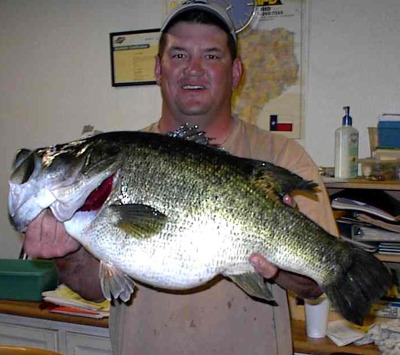Back in the spring of 2006, Billy Greeson had a monster day on the water while bass fishing.
The Amarillo firefighter caught a 15-pound largemouth bass on a black and blue jig on the final day of March, setting the Lake Alan Henry record, which still stands to this day. And while that fish was a surefire hawg, the rest of the story is almost as impressive. In addition to the big female that was entered into the ShareLunker program and later released, Greeson also caught a 10-pound largemouth and seven other bass over 7 pounds.
“It was probably just luck,” he said.
While he was being modest, any seasoned angler will tell you that when it comes to finding big fish this time of year, you make your own luck.
The spring spawn is under way on a number of South Texas lakes where conditions are warmer and the magic time soon will hit lakes in this part of the world as water temperatures rise from the 50s into the 60s. When most anglers think of fishing the spawn, the term “sight fishing” comes to mind, and for good reason – many of the biggest bass caught each year have moved up shallow enough so anglers can see and cast to them. However, just because you can see a fish doesn’t mean you can get them to bite, which is the most maddening aspect of fishing in and around the spawn.
With that in mind, here are some tips and tactics that could aid in locating, enticing and landing a spring lunker while bass fishing.
Big and bright: Utilizing larger baits that are more brilliantly colored can help entice a bite in a couple of scenarios. If a bass is holding on a bed, any unlucky intruder will be sent packing, but if they can see your bait easier, they’ll be more likely to pounce. Some of the most common baits that will drive bedded bass crazy are large salamanders, worms and crawfish. A bright bait also will allow you to see it better in the water if you’re sight fishing. Another plus to using larger baits is many anglers think they catch larger fish. This certainly could hold true if a fish is in a staging area and is looking to maximize its gluttonous efforts.
Go heavy: Targeting trees, stumps and other cover can be hard on fishing line, which is the critical link to your lure. Using heavier tackle is key in these instances, especially if you hook a lunker and need to horse them out of a tight spot quickly before they get hung up. Braided line is en vogue, even by some anglers using spinning tackle, though fluorocarbon of 20-pound test or so also will work in most fishing circumstances, unless you’re targeting thick hydrilla or something similar in deeper water.
Flip and pitch: Anglers who like targeting cover typically rely on flipping and pitching to introduce a lure into a tight spot without a regular cast. This can up your chances of targeting fish that are holding tight in pre-spawn staging areas and also when you need to put a lure near a bed without spooking a fish. Flipping, which is used for closer targets, involves peeling off a certain amount of line and then sending it through the guides as you drop and lift your rod. Pitching involves letting a bait go from your hand using an underhand pitching movement while you keep a thumb on the spool.
Set the stage: Big bass that are preparing to spawn or have spawned will utilize staging areas in deeper water and cover, especially if cooler weather moves through. While shallow coves and other areas are the first places to look for spawners, consider throwing a crankbait, spinner bait or buzzbait into places leading away from those spots to pick up fish that could be coming and going.
Eyes up: No deer hunter I know would dare leave their optics at home, and by the same token, bass anglers shouldn’t go without polarized sunglasses. They allow an angler to not only spot fish but also cleared nest areas near where fish could be lurking. There are a number of colored lenses that allow anglers to see into the water and choice mostly is one of preference, though amber-colored lenses offer more contrast in most fishing situations. Eye protection also is a good thing when you jerk a bait snagged on an obstruction and it bites back at you.
Silence is golden: It should be second nature to keep as quiet as possible, but if fish are in the shallows, it’s easier for them to pick up on sound and movement, which could turn them off to your advances. A couple of things to consider, among others, are limiting the on/off of a trolling motor and setting up so a bass must glare into the sun if it looks your way from a bed.
Read the weather: Warmer temperatures push bass to feed and to spawn, especially if they’re consistent for at least a few days. It should be noted that northern shorelines receive more warmth during the day in the spring due to the position of the sun and the earth, which could mean those areas would harbor spawning fish sooner than other portions of a lake.
The only guarantee in spring bass fishing is that your chances to have your own monster day on the water quickly rise as temperatures do the same. This time of year, the chores can wait!



















